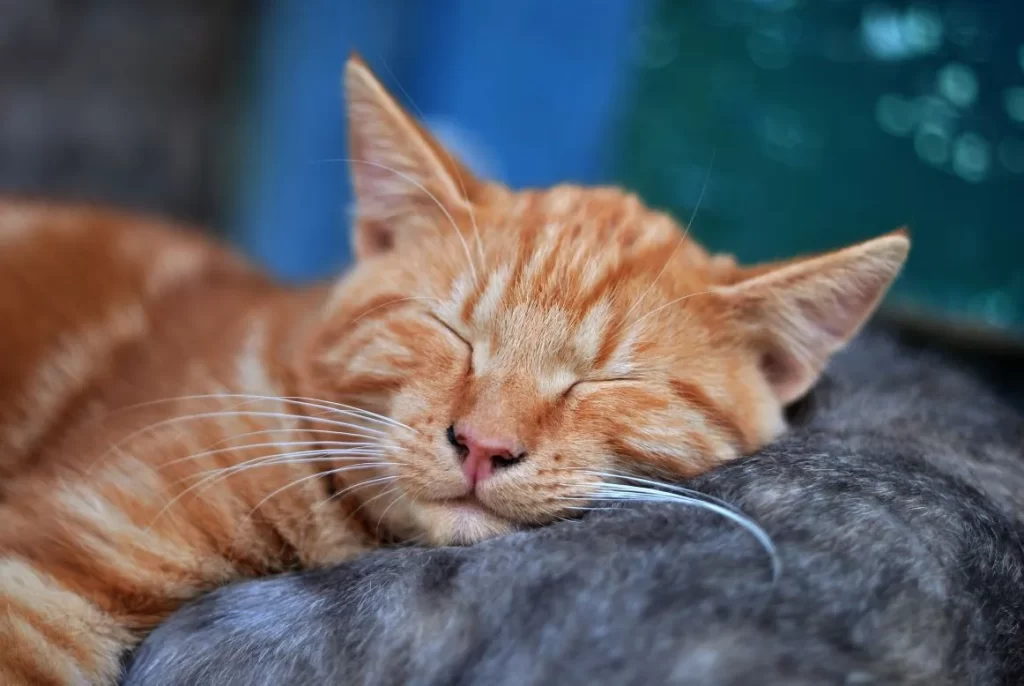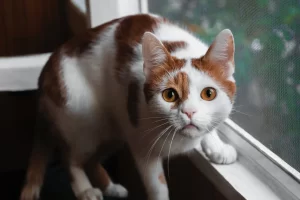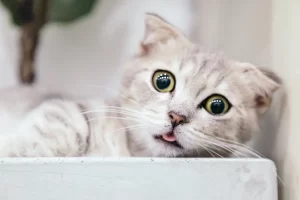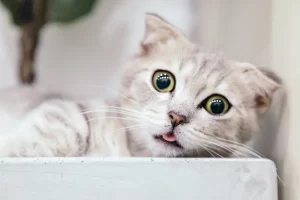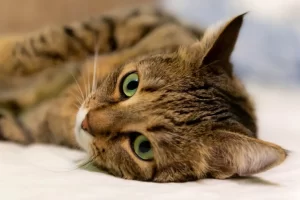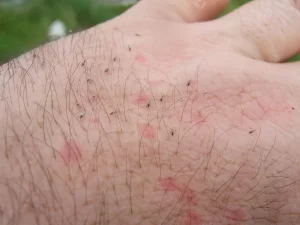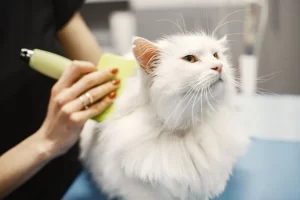Feline calicivirus is a common viral infection that affects cats. It can cause a variety of symptoms including fever, loss of appetite, and respiratory issues. While there is no cure for feline calicivirus, proper treatment and care can help alleviate symptoms and prevent the virus from spreading to other cats. This article will provide an overview of the various treatment options available for managing feline calicivirus at home, including supportive care, measures to prevent the spread of the virus, and when it is necessary to seek veterinary assistance.
Table of Contents
ToggleMain symptoms of feline calicivirus (FCV)
The main symptoms of feline calicivirus (FCV) include:
- Fever
- Loss of appetite
- Respiratory issues such as sneezing, nasal discharge, and coughing
- Oral ulcers
- Lameness
- Swelling of the face, paws, and joints
It’s important to note that some cats may not show any symptoms, while others may have severe symptoms. It can also cause severe upper respiratory infections and pneumonia.
To confirm if a cat has FCV, a veterinarian will typically perform a physical examination and may also take a sample of the cat’s nasal discharge or saliva for testing.
It’s important to note that FCV is highly contagious and can spread easily from cat to cat through direct contact, or through contact with contaminated objects such as food bowls or litter boxes. If you suspect your cat may have feline calicivirus, it is important to seek veterinary care as soon as possible to prevent the spread of the virus and to help manage the symptoms.
What causes Feline calicivirus in cats
Feline calicivirus (FCV) is caused by a virus of the same name. The virus belongs to the Caliciviridae family and is highly contagious. It spreads through direct contact between cats or through contact with contaminated objects such as food bowls, litter boxes, and bedding. The virus can also be spread through the air, making it easy for it to spread quickly among cats in close proximity.
Other factors that may contribute to the spread of FCV include:
- Crowded living conditions: FCV is more likely to spread in environments with many cats, such as shelters and breeding facilities.
- Stress: Cats that are under stress, such as those that have recently been moved or introduced to new cats, may be more susceptible to contracting FCV.
- Poor hygiene: A lack of proper sanitation and cleaning can also contribute to the spread of FCV.
- Immunocompromised cats: Cats that have a weakened immune system may be more susceptible to contracting FCV and may have a harder time fighting off the virus.
It’s important to note that FCV can mutate to a more virulent form and cause severe respiratory infections, pneumonia, and oral ulcers which can be difficult to treat.
Home treatment options for feline calicivirus
There are several home treatment options that can be used to manage symptoms of feline calicivirus (FCV) in cats. These options can be categorized into several different categories:
Supportive care:
- Providing a healthy diet and ensuring adequate hydration to help support the cat’s immune system
- Creating a quiet and warm environment to help the cat feel comfortable during recovery
Oral care:
- managing oral ulcers, such as by providing soft food or using a feeding syringe
- preventing secondary infections by keeping the cat’s mouth clean and providing oral medications as prescribed by a veterinarian.
Respiratory care:
- managing respiratory symptoms, such as nasal discharge and coughing
- keeping the cat isolated to prevent the spread of the virus to other cats.
Cleaning and Disinfecting:
- Clean and disinfect the environment regularly to prevent the spread of the virus
- Monitoring the cat’s progress and when to seek veterinary assistance
Managing secondary infections:
- Treating any secondary infections that may occur, such as bacterial infections, as directed by a veterinarian.
Managing lameness or joint swelling:
- managing any lameness or joint swelling symptoms by providing rest and medication as prescribed by a veterinarian.
Managing eye or nose discharge:
- managing any eye or nose discharge by keeping the area clean and providing medication as directed by a veterinarian.
It’s important to note that these home treatment options should be used in conjunction with veterinary care and under the guidance of a veterinarian. It’s also important to monitor your cat’s condition closely and seek veterinary assistance if the cat’s condition worsens or if the symptoms persist.

Supportive care for feline calicivirus
Supportive care is a crucial aspect of managing feline calicivirus (FCV) in cats. Here are some specific examples of how to provide supportive care for your cat at home:
- Providing a healthy diet: A healthy diet can help support the cat’s immune system and aid in recovery. It’s important to provide a diet that is high in protein and essential nutrients, such as a high-quality, protein-rich wet food, or a balanced homemade diet.
- Ensuring adequate hydration: Adequate hydration is important for maintaining overall health and can help support the cat’s immune system. To ensure your cat is getting enough water, you can try adding wet food to its diet, placing multiple water bowls around the house, or using a water fountain.
- Creating a quiet and warm environment: FCV can be stressful for cats, so it’s important to provide a quiet and warm environment that will help the cat feel comfortable during recovery. This may include providing a cozy bed or a warm blanket and keeping the room at a comfortable temperature.
- Providing rest: FCV can cause fatigue and weakness, so it’s important to provide plenty of rest for your cat during recovery. This means avoiding excessive play or physical activity and keeping the cat in a quiet, peaceful environment.
- Monitoring the cat’s condition: It’s important to monitor the cat’s condition closely and to seek veterinary assistance if the cat’s condition worsens or if the symptoms persist. Signs of the worsening condition include difficulty breathing, lack of appetite, increased lethargy, and the presence of new or worsening symptoms.
- Reducing stress: FCV can make cats more susceptible to stress, so it’s important to reduce stress as much as possible. This may include providing a quiet and calm environment, spending more time with the cat, using pheromone sprays or plug-ins, or providing a hiding spot for the cat to retreat to.
Administering medication: Medications may be prescribed by a veterinarian to help manage symptoms such as fever and inflammation. These medications should be administered as directed by a veterinarian, following the instructions on the label or as advised by the veterinarian. It’s important to note that supportive care should be used in conjunction with veterinary care and under the guidance of a veterinarian. It’s also important to monitor your cat’s condition closely and seek veterinary assistance if the cat’s condition worsens or if the symptoms persist.
Read More: How often do you take a cat to the vet?
Oral care for feline calicivirus
Oral care is an important aspect of managing feline calicivirus (FCV) in cats, as the virus can cause ulcers and sores in the mouth, making it difficult for cats to eat and drink. Here are some specific examples of how to provide oral care for your cat at home:
- Brush your cat’s teeth: Brushing your cat’s teeth can help prevent plaque and tartar buildup, which can exacerbate oral ulcers caused by FCV. Use a toothbrush and toothpaste specifically made for cats, and start by getting your cat used to having their mouth touched and then slowly introduce the toothbrush.
- Provide dental-specific food and treats: Dental-specific food and treats can help keep your cat’s teeth clean and healthy. These products are formulated to break down plaque and tartar as the cat chews.
- Provide water additives: Water additives can help reduce plaque and tartar buildup on your cat’s teeth. These products are added to the cat’s water bowl, and as the cat drinks, the additive coats its teeth, helping to reduce plaque and tartar buildup.
- Rinsing the mouth: Rinsing your cat’s mouth with a saltwater solution (1/4 tsp of salt in 8 oz of warm water) is among the other home remedies that can help soothe soreness and discomfort caused by FCV. Rinsing the mouth twice a day after eating. It’s important to note that oral care should be used in conjunction with veterinary care and under the guidance of a veterinarian. It’s also important to monitor your cat’s condition closely and seek veterinary assistance if the cat’s condition worsens or if the symptoms persist.
Respiratory care for feline calicivirus
Providing proper respiratory care is a crucial aspect of managing feline calicivirus (FCV) in cats, particularly because the virus can lead to respiratory tract infections and inflammation. Here are specific ways to offer respiratory care for your cat at home:
- Maintain a Clean and Well-Ventilated Living Space: A clean and well-ventilated living area is essential for reducing the risk of respiratory infections due to FCV. Perform daily litter box cleaning and consider using a HEPA air filter to eliminate airborne particles.
- Ensure Humidity: A humid environment can alleviate your cat’s respiratory discomfort and mitigate FCV symptoms. You can achieve this by using a humidifier in your cat’s living space or placing a shallow dish of water nearby.
- Steam Therapy: Steam therapy can effectively clear your cat’s nasal passages and provide relief from FCV-induced respiratory symptoms. Boil a pot of water and place it on a secure surface, allowing your cat to sit with its face at a safe distance of at least 10 inches from the pot in the steam for 10-15 minutes.
- Medication Administration: If a veterinarian prescribes medication for your cat, it is crucial to adhere to the label instructions and administer the medication precisely as directed. Medications like anti-inflammatories and antibiotics can help reduce the severity of respiratory symptoms resulting from FCV.
Cleaning and Disinfecting for feline calicivirus
Cleaning and disinfecting are important aspects of managing feline calicivirus (FCV) in cats, as the virus can easily spread to other cats and surfaces. Here are some specific examples of how to clean and disinfect your cat’s living area and belongings:
- Clean and disinfect all surfaces: Clean and disinfect all surfaces in your cat’s living area, including floors, walls, and furniture. Use a mild detergent and warm water to clean surfaces, and then use a disinfectant specifically labeled for use on surfaces to kill the FCV virus.
- Laundry and bedding: Wash your cat’s bedding, blankets, and any other fabric items in hot water and a mild detergent. Dry the items completely in a dryer on high heat.
- Clean and disinfect litter boxes: Clean and disinfect your cat’s litter box daily. Scoop out the feces and urine, and then clean the litter box with a mild detergent and warm water. Then disinfect the litter box with a disinfectant specifically labeled for use on surfaces to kill the FCV virus.
- Dispose of contaminated items: Items such as food and water bowls, toys, and grooming tools that may have been in contact with the virus should be washed and disinfected or discarded.
- Personal hygiene: It’s important to practice good personal hygiene when handling your cat. Wash your hands before and after handling your cat and after cleaning and disinfecting their living area.
It’s important to note that cleaning and disinfecting should be used in conjunction with veterinary care and under the guidance of a veterinarian. It’s also important to monitor your cat’s condition closely and seek veterinary assistance if the cat’s condition worsens or if the symptoms persist.
Managing secondary infections in feline calicivirus
Managing secondary infections is an important aspect of managing feline calicivirus (FCV) in cats, as the virus can weaken a cat’s immune system and make them more susceptible to other infections. Here are some specific examples of how to manage secondary infections in cats with FCV:
- Keep the cat’s living area clean and well-ventilated: Keeping your cat’s living area clean and well-ventilated can help reduce the risk of secondary infections caused by FCV. Clean the litter box daily, and use a HEPA air filter to remove any airborne particles.
- Administering Medications: If your cat is prescribed medication by a veterinarian, it is important to follow the instructions on the label and administer the medication as directed. Medications such as antibiotics can help prevent or treat secondary infections such as bacterial infections.
- Regular veterinary check-ups: Regular check-ups with a veterinarian can help detect and treat secondary infections early before they become severe. Your veterinarian may also perform diagnostic tests such as a blood test or cultures to identify and confirm any secondary infections.
- Keep an eye on your cat’s symptoms: Keep an eye on your cat’s symptoms and seek veterinary assistance if you notice any changes or if the symptoms persist. Some signs of secondary infections include increased coughing, sneezing, nasal or ocular discharge, or appetite loss.
- Provide a healthy diet: Provide your cat with a healthy diet that will help boost its immune system and improve its overall health.
It’s important to note that managing secondary infections should be used in conjunction with veterinary care and under the guidance of a veterinarian. It’s also important to monitor your cat’s condition closely and seek veterinary assistance if the cat’s condition worsens or if the symptoms persist.
Managing eye or nose discharge in feline calicivirus
Managing eye or nose discharge is an important aspect of managing feline calicivirus (FCV) in cats, as the virus can cause inflammation in the respiratory tract and lead to discharge from the eyes or nose. Here are some specific examples of how to manage eye or nose discharge in cats with FCV:
- Keep the cat’s living area clean: Keep the cat’s living area clean, such as by cleaning the litter box daily and using a HEPA air filter to remove any airborne particles. This can help reduce the risk of secondary infections and irritation caused by FCV.
- Administering Medications: If your cat is prescribed medication by a veterinarian, it is important to follow the instructions on the label and administer the medication as directed. Medications such as antibiotics and anti-inflammatory drugs can help prevent or treat secondary infections and reduce inflammation in the respiratory tract.
- Keep an eye on your cat’s symptoms: Keep an eye on your cat’s symptoms and seek veterinary assistance if you notice any changes or if the symptoms persist. Some signs of eye or nose discharge include increased coughing, sneezing, nasal or ocular discharge, or appetite loss.
- Regular veterinary check-ups: Regular check-ups with a veterinarian can help detect and treat eye or nose discharge early before they become severe. Your veterinarian may also perform diagnostic tests such as a blood test or cultures to identify and confirm any secondary infections.
- Provide a humid environment: Provide a humid environment for your cat, such as by using a humidifier in the room. This can help reduce dryness and discomfort in the respiratory tract.
- Cleaning the eyes and nose: Gently clean the eyes and nose of your cat with a damp cloth or cotton ball to remove any discharge. Be sure to use a separate cloth or cotton ball for each eye to avoid spreading any infection.
Seeking veterinary care for suspected FCV in cats
Seeking veterinary care if you suspect your cat has feline calicivirus (FCV) is extremely important for several reasons:
- Confirmation of diagnosis: A veterinarian will be able to perform a physical examination and may also take a sample of the cat’s nasal discharge or saliva for testing to confirm the diagnosis of FCV.
- Treatment options: Your veterinarian will be able to provide treatment options for managing symptoms, such as medications to reduce fever and inflammation and to help manage oral ulcers.
- Preventing the spread of the virus: FCV is highly contagious and can spread easily from cat to cat. Your veterinarian will be able to provide recommendations for preventing the spread of the virus, such as keeping the infected cat isolated and cleaning and disinfecting the environment.
- Monitoring progress: Your veterinarian will be able to monitor your cat’s progress and make adjustments to treatment as needed. They will also be able to advise you when it’s necessary to seek additional veterinary assistance.
- Vaccination: Your veterinarian will also advise you on the importance of vaccination as a preventative measure.
- Long-term effects: FCV can have long-term effects and may cause chronic problems such as chronic rhinitis, gingivitis, and lameness. Your veterinarian will be able to advise you on how to manage these long-term effects and provide ongoing care.
In summary, seeking veterinary care as soon as you suspect your cat may have FCV is essential for making a proper diagnosis, providing appropriate treatment, preventing the spread of the virus, monitoring your cat’s progress, and addressing any long-term effects.
Medical treatments and over-the-counter medicines
Medical treatments and over-the-counter (OTC) medicines can be an important part of managing feline calicivirus (FCV) in cats. Here are some examples of medical treatments and OTC medicines that may be used to manage FCV:
- Antiviral medications: Antiviral medications, such as ribavirin and cidofovir, can be prescribed by a veterinarian to help decrease the severity and duration of FCV symptoms. These medications work by inhibiting the replication of the FCV virus and can be administered orally or intravenously.
- Antibiotics: Antibiotics can be prescribed by a veterinarian to treat secondary infections that may develop as a result of FCV. For example, if a cat with FCV develops a secondary bacterial infection in the respiratory tract, an antibiotic may be prescribed to help clear the infection.
- Anti-inflammatory medications: Anti-inflammatory medications, such as corticosteroids, can be prescribed by a veterinarian to help reduce inflammation and swelling in the respiratory tract. These medications can help alleviate symptoms such as coughing and sneezing and can also help prevent secondary infections. If you prefer natural remedies, try these cat sneezing home treatments.
- Pain medications: Pain medications, such as non-steroidal anti-inflammatory drugs (NSAIDs), can be prescribed by a veterinarian to help manage pain and discomfort caused by FCV.
- Vitamin and mineral supplements: Vitamin and mineral supplements, such as vitamin C and zinc, can be given to cats with FCV to help boost their immune system and support recovery.
- OTC decongestant: Over-the-counter decongestants such as phenylephrine or oxymetazoline can be used to help relieve nasal congestion in cats with FCV.
It’s important to note that medical treatments and OTC medicines should be used under the guidance of a veterinarian, as they may have potential side effects or interact with other medications that the cat is taking.
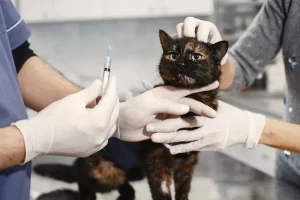
The importance of vaccination in preventing feline calicivirus
Vaccination is one of the most effective ways to protect cats from feline calicivirus (FCV) infection. Vaccines are available that can help protect against the different strains of FCV, and they can be given as part of a cat’s regular vaccinations.
The most common vaccines used to protect against FCV are the FVRCP (feline viral rhinotracheitis, calicivirus, and panleukopenia) and the Feline Calicivirus (FCV) vaccines. These vaccines can help protect against the most common strains of FCV, and they are typically given as a series of 2 or 3 injections, with booster shots given annually.
It’s important to consult with a veterinarian to determine the best vaccination schedule for your cat. Some cats may be at a higher risk of infection, such as cats that live in multi-cat households, cats that go outside, or cats that have a weakened immune system. These cats may benefit from more frequent vaccinations.
What happens if feline calicivirus is left untreated?
If left untreated, feline calicivirus (FCV) can lead to serious and potentially life-threatening complications. Some of the most common consequences of untreated FCV include:
- Pneumonia: FCV can cause severe respiratory infections, which can lead to pneumonia. Pneumonia can be fatal if not treated promptly and appropriately.
- Secondary infections: FCV can weaken the immune system, making cats more susceptible to other infections. These secondary infections can include bacterial infections, such as abscesses or sepsis, or fungal infections, such as candidiasis.
- Lameness: FCV can cause joint swelling and pain, leading to lameness. This can be chronic and debilitating and may require long-term management.
- Chronic health problems: Some cats that have been infected with FCV may develop chronic health problems, such as chronic rhinitis, gingivitis, or stomatitis. These conditions can be difficult to manage, and can significantly reduce the cat’s quality of life.
Will feline calicivirus go away on its own?
Feline calicivirus (FCV) is a highly contagious viral infection that can cause a range of symptoms in cats. Some cats may recover from the infection on their own, but this is not always the case.
In some cats, FCV can lead to severe and potentially life-threatening complications if left untreated, such as pneumonia, secondary infections, lameness, and chronic health problems.
Even if a cat seems to recover from FCV on their own, it may still be a carrier of the virus and be able to spread it to other cats. It is important to seek veterinary care if you suspect your cat may have FCV, as early treatment can help prevent serious complications.
Also, it’s important to note that even if a cat recovers from FCV, it may still be at risk of developing chronic health problems, such as chronic rhinitis, gingivitis, or stomatitis. Even if the cat seems to have recovered, it is important to visit a veterinarian for a check-up and follow-up care.

